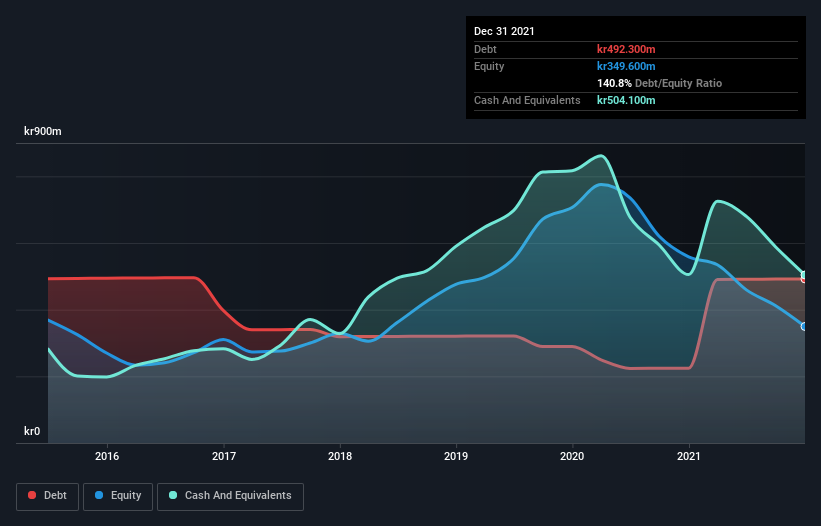
Howard Marks put it nicely when he said that, rather than worrying about share price volatility, 'The possibility of permanent loss is the risk I worry about... and every practical investor I know worries about.' When we think about how risky a company is, we always like to look at its use of debt, since debt overload can lead to ruin. We can see that Orexo AB (publ) (STO:ORX) does use debt in its business. But is this debt a concern to shareholders?
Why Does Debt Bring Risk?
Debt and other liabilities become risky for a business when it cannot easily fulfill those obligations, either with free cash flow or by raising capital at an attractive price. If things get really bad, the lenders can take control of the business. While that is not too common, we often do see indebted companies permanently diluting shareholders because lenders force them to raise capital at a distressed price. Of course, debt can be an important tool in businesses, particularly capital heavy businesses. When we examine debt levels, we first consider both cash and debt levels, together.
Check out our latest analysis for Orexo
What Is Orexo's Net Debt?
As you can see below, at the end of December 2021, Orexo had kr492.3m of debt, up from kr224.5m a year ago. Click the image for more detail. However, it does have kr504.1m in cash offsetting this, leading to net cash of kr11.8m.

How Healthy Is Orexo's Balance Sheet?
According to the last reported balance sheet, Orexo had liabilities of kr380.2m due within 12 months, and liabilities of kr543.9m due beyond 12 months. On the other hand, it had cash of kr504.1m and kr256.7m worth of receivables due within a year. So its liabilities total kr163.3m more than the combination of its cash and short-term receivables.
This deficit isn't so bad because Orexo is worth kr652.9m, and thus could probably raise enough capital to shore up its balance sheet, if the need arose. However, it is still worthwhile taking a close look at its ability to pay off debt. While it does have liabilities worth noting, Orexo also has more cash than debt, so we're pretty confident it can manage its debt safely. When analysing debt levels, the balance sheet is the obvious place to start. But it is future earnings, more than anything, that will determine Orexo's ability to maintain a healthy balance sheet going forward. So if you want to see what the professionals think, you might find this free report on analyst profit forecasts to be interesting.
Over 12 months, Orexo made a loss at the EBIT level, and saw its revenue drop to kr565m, which is a fall of 15%. That's not what we would hope to see.
So How Risky Is Orexo?
Statistically speaking companies that lose money are riskier than those that make money. And we do note that Orexo had an earnings before interest and tax (EBIT) loss, over the last year. Indeed, in that time it burnt through kr282m of cash and made a loss of kr224m. With only kr11.8m on the balance sheet, it would appear that its going to need to raise capital again soon. Overall, we'd say the stock is a bit risky, and we're usually very cautious until we see positive free cash flow. When analysing debt levels, the balance sheet is the obvious place to start. However, not all investment risk resides within the balance sheet - far from it. We've identified 2 warning signs with Orexo , and understanding them should be part of your investment process.
Of course, if you're the type of investor who prefers buying stocks without the burden of debt, then don't hesitate to discover our exclusive list of net cash growth stocks, today.
New: AI Stock Screener & Alerts
Our new AI Stock Screener scans the market every day to uncover opportunities.
• Dividend Powerhouses (3%+ Yield)
• Undervalued Small Caps with Insider Buying
• High growth Tech and AI Companies
Or build your own from over 50 metrics.
Have feedback on this article? Concerned about the content? Get in touch with us directly. Alternatively, email editorial-team (at) simplywallst.com.
This article by Simply Wall St is general in nature. We provide commentary based on historical data and analyst forecasts only using an unbiased methodology and our articles are not intended to be financial advice. It does not constitute a recommendation to buy or sell any stock, and does not take account of your objectives, or your financial situation. We aim to bring you long-term focused analysis driven by fundamental data. Note that our analysis may not factor in the latest price-sensitive company announcements or qualitative material. Simply Wall St has no position in any stocks mentioned.
About OM:ORX
Orexo
A specialty pharmaceutical company, develops and commercializes pharmaceuticals and digital therapies in the United States, European Union, and internationally.
Slight and fair value.
Similar Companies
Market Insights
Community Narratives



